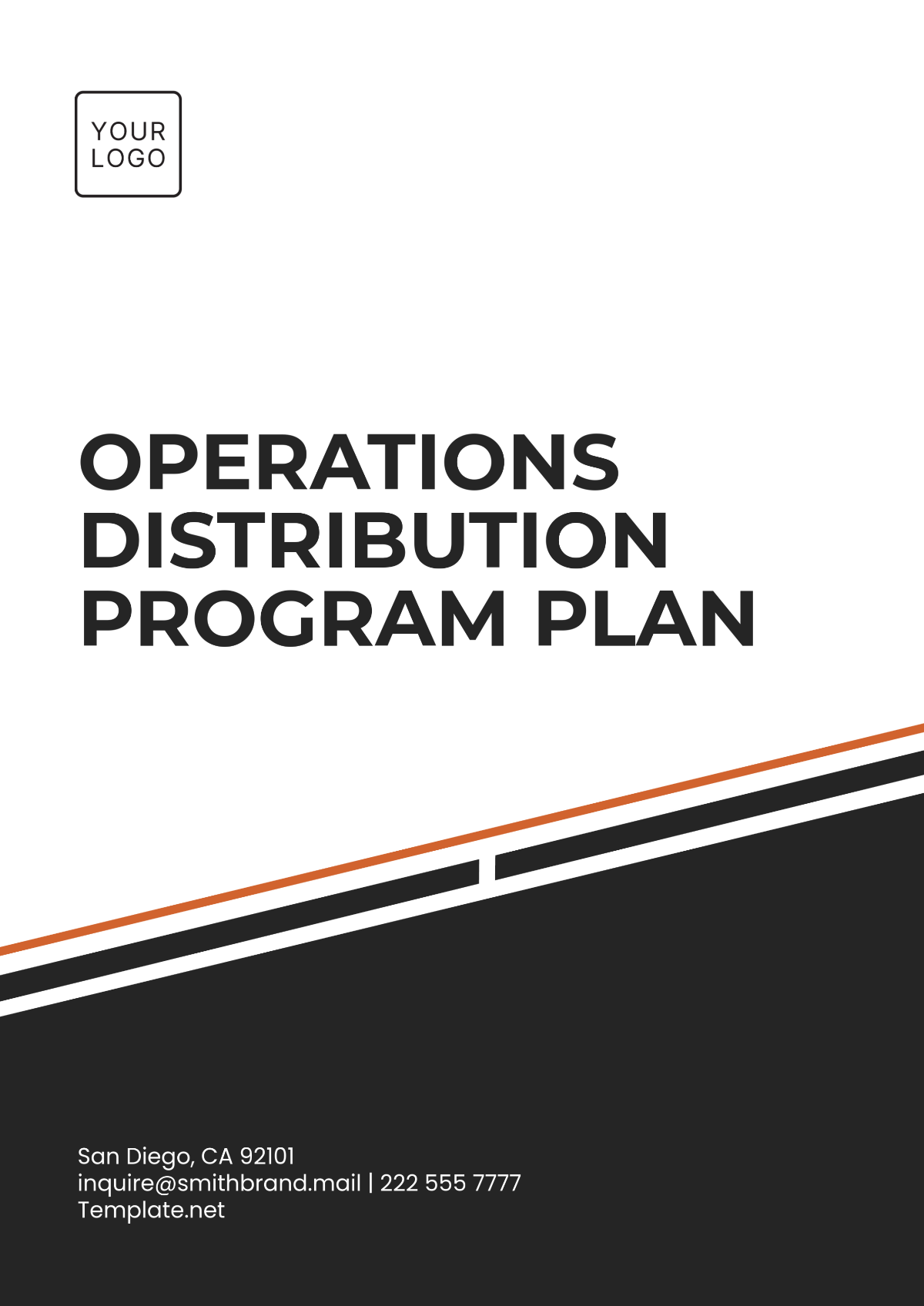Free Operations Distribution Program Plan

In today's competitive market landscape, efficient distribution operations play a pivotal role in ensuring customer satisfaction and maintaining a competitive edge. This Operations Distribution Program Plan by [Your Company Name] is designed to streamline distribution processes, optimize resource utilization, and enhance overall operational efficiency.
I. Objectives
The primary objectives of the Operations Distribution Program are multifaceted and include:
Ensuring timely and accurate delivery of products/services to customers, thereby enhancing customer satisfaction and loyalty.
Optimizing distribution processes to reduce operational costs, improve resource utilization, and maximize profitability.
Enhancing inventory management and tracking capabilities to minimize stockouts, reduce excess inventory holding costs, and improve inventory turnover rates.
Implementing proactive measures for risk mitigation and contingency planning to address potential disruptions in the supply chain or distribution network.
II. Distribution Channels
[Your Company Name] employs a diversified distribution strategy encompassing various channels to reach target customers effectively:
Direct Sales: Direct-to-consumer sales channels facilitated through [Your Company Website], brick-and-mortar retail locations, and dedicated sales representatives.
Retail Partnerships: Collaborative partnerships with retail chains and specialty stores for product placement and distribution.
E-commerce Platforms: Leveraging online marketplaces such as [Your Company Website], Amazon, eBay, and others to expand reach and facilitate online sales.
Wholesale: Bulk distribution to wholesalers, distributors, or resellers who further distribute products to retailers or end consumers.
III. Distribution Strategy
To achieve our distribution objectives, [Your Company Name] will implement the following strategic initiatives:
Optimized Routing: Deploy advanced route optimization software to plan the most efficient delivery routes, considering factors such as traffic patterns, delivery windows, and vehicle capacity, thereby minimizing fuel consumption and transit times.
Warehouse Management: Adoption of state-of-the-art warehouse management systems (WMS) to streamline inventory management processes, including receiving, storage, picking, packing, and shipping. This will enhance operational efficiency, reduce errors, and improve order fulfillment accuracy.
Real-time Tracking and Visibility: Implementation of GPS tracking, RFID technology, and other tracking solutions to provide real-time visibility into the movement of goods throughout the supply chain. This will enable proactive monitoring, accurate delivery tracking for customers, and timely intervention in case of exceptions or delays.
Quality Control Measures: Implementation of stringent quality control protocols and inspection procedures at distribution centers to ensure that products meet quality standards before shipment. This will help minimize returns, rework, and customer complaints, thereby enhancing brand reputation and customer satisfaction.
Cross-docking Optimization: Utilization of cross-docking strategies to facilitate the direct transfer of goods from inbound to outbound transportation, minimizing inventory holding times, reducing warehousing costs, and improving overall supply chain efficiency.
IV. Key Performance Indicators (KPIs)
Measuring performance against key indicators is essential for evaluating the effectiveness of the Operations Distribution Program. Key performance indicators (KPIs) to be tracked include:
On-time Delivery Rate: The percentage of orders delivered within the promised timeframe.
Order Accuracy Rate: The percentage of orders fulfilled accurately without errors or discrepancies.
Inventory Turnover Ratio: The rate at which inventory is sold and replaced within a specific period.
Cost per Delivery: The average cost incurred for each delivery, including transportation, handling, and overhead expenses.
Customer Satisfaction Score (related to distribution): The level of customer satisfaction with the distribution process, measured through surveys, feedback, or Net Promoter Score (NPS).
V. Risk Management
[Your Company Name] recognizes the importance of proactive risk management to mitigate potential disruptions and ensure continuity in distribution operations. Key risk management strategies include:
Supply Chain Resilience: Develop robust contingency plans to address potential risks such as natural disasters, geopolitical events, supplier failures, or raw material shortages. This may involve diversifying supplier networks, maintaining safety stock levels, or establishing alternative transportation routes.
Transportation Risk Mitigation: Identifying and mitigating risks associated with transportation, including delays, accidents, theft, or regulatory compliance issues. This may involve implementing GPS tracking, route optimization, and driver safety programs, as well as securing cargo through insurance or security measures.
VI. Implementation Plan
The successful implementation of the Operations Distribution Program will involve the following phased approach:
Assessment and Analysis: Conduct a comprehensive assessment of existing distribution processes, infrastructure, and technology capabilities to identify strengths, weaknesses, and improvement opportunities.
Technology Integration: Procure and deploy advanced distribution management software, hardware, and tracking technologies to support optimized routing, warehouse management, and real-time visibility.
Training and Capacity Building: Provide specialized training and skill development programs to distribution staff, supervisors, and managers to familiarize them with new processes, tools, and best practices.
Pilot Testing and Optimization: Conduct pilot tests of new distribution strategies and technologies in select regions or markets to evaluate performance, identify challenges, and fine-tune processes for maximum efficiency.
Full-scale Rollout and Monitoring: Gradually implement the optimized distribution strategies across all regions, closely monitoring key performance indicators (KPIs), and addressing any issues or deviations through continuous improvement initiatives.
VII. Conclusion
The Operations Distribution Program Plan outlined by [Your Company Name] reflects our commitment to excellence in distribution operations, customer service, and business performance. By leveraging advanced technologies, best practices, and proactive risk management strategies, we aim to enhance operational efficiency, reduce costs, and exceed customer expectations in the delivery of our products/services.
For inquiries or further information, please contact [Your Name] at [Your Company Email].
- 100% Customizable, free editor
- Access 1 Million+ Templates, photo’s & graphics
- Download or share as a template
- Click and replace photos, graphics, text, backgrounds
- Resize, crop, AI write & more
- Access advanced editor
Discover the comprehensive Operations Procurement Policy Template on Template.net. Easily editable and customizable, this template empowers you to craft a tailored procurement policy that aligns with your organization's objectives and compliance requirements. Utilize our intuitive Ai Editor Tool to make modifications effortlessly. Strengthen your procurement processes and enhance transparency and accountability with this essential policy template.





























